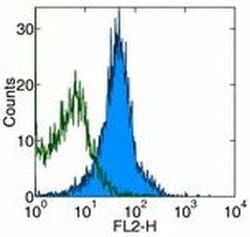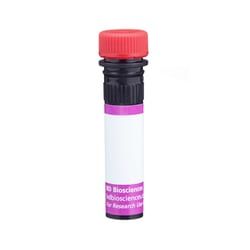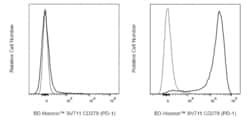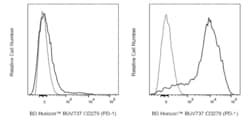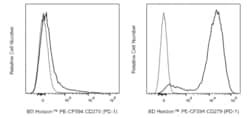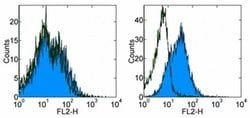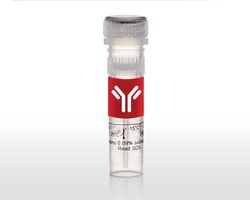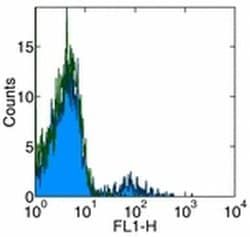14-998-185
CD279 (PD-1) Monoclonal Antibody (RMP1-30), eBioscience™, Invitrogen™
Manufacturer: Fischer Scientific
Select a Size
| Pack Size | SKU | Availability | Price |
|---|---|---|---|
| Each of 1 | 14-998-185-Each-of-1 | In Stock | ₹ 31,773.00 |
14-998-185 - Each of 1
In Stock
Quantity
1
Base Price: ₹ 31,773.00
GST (18%): ₹ 5,719.14
Total Price: ₹ 37,492.14
Antigen
CD279 (PD-1)
Classification
Monoclonal
Concentration
0.5 mg/mL
Formulation
PBS with 0.09% sodium azide; pH 7.2
Gene Accession No.
Q02242
Gene Symbols
Pdcd1
Purification Method
Affinity chromatography
Regulatory Status
RUO
Gene ID (Entrez)
18566
Content And Storage
4° C
Form
Liquid
Applications
Flow Cytometry
Clone
RMP1-30
Conjugate
Unconjugated
Gene
Pdcd1
Gene Alias
CD279; EGK_05005; hPD1; hPD-1; hPD-l; hSLE1; Ly101; mPD-1; PD1; PD-1; Pdc1; Pdcd1; programmed cell death 1; programmed cell death 1 protein; programmed cell death protein 1; programmed cell death protein 1-like; programmed death 1; Protein PD1; protein PD-1; sCD279; SLEB2; soluble CD279; systemic lupus erythematosus susceptibility 2
Host Species
Rat
Quantity
500 μg
Primary or Secondary
Primary
Target Species
Mouse
Product Type
Antibody
Isotype
IgG2b κ
Description
- Description: The RMP1-30 antibody reacts with mouse PD-1 (programmed death-1), a 55 kDa member of the Ig superfamily
- PD-1 contains the immunoreceptor tyrosine-based inhibitory motif (ITIM) and plays a key role in peripheral tolerance and autoimmune disease in mice
- PD-1 is expressed mainly on activated T and B lymphocytes
- Two novel B7 Family members have been identified as PD-1 ligands, PD-L1 (B7-H1) and PD-L2 (B7-DC)
- Evidence reported to date suggests overlapping functions for these ligands and their constitutive expression on some normal tissues and upregulation on activated antigen-presenting cells
- RMP1-30 does not block the binding of either B7-H1-Ig or B7-DC-Ig to PD-1 transfectants
- Applications Reported: The RMP1-30 antibody has been reported for use in flow cytometric analysis
- Applications Tested: The RMP1-30 antibody has been tested by flow cytometric analysis of Con A-stimulated mouse splenocytes
- This can be used at less than or equal to 0.5 μg per test
- A test is defined as the amount (μg) of antibody that will stain a cell sample in a final volume of 100 μL
- Cell number should be determined empirically but can range from 10^5 to 10^8 cells/test
- It is recommended that the antibody be carefully titrated for optimal performance in the assay of interest
- Purity: Greater than 90%, as determined by SDS-PAGE
- Aggregation: Less than 10%, as determined by HPLC
- Filtration: 0.2 μm post-manufacturing filtered
- Cell-mediated immune responses are initiated by T lymphocytes that are themselves stimulated by cognate peptides bound to MHC molecules on antig en-presenting cells (APC)
- T-cell activation is generally self-limited as activated T cells express receptors such as PD-1 (also known as PDCD-1) that mediate inhibitory signals from the APC
- PD-1 can bind two different but related ligands, PDL-1 and PDL-2
- Upon binding to either of these ligands, signals generated by PD-1 inhibit the activation of the immune response in the absence of "edanger signals"e such as LPS or other molecules associated with bacteria or other pathogens
- Evidence for this is seen in PD1-null mice who exhibit hyperactivated immune systems and autoimmune diseases
- Despite its predicted molecular weight, PD-1 often migrates at higher molecular weight in SDS-PAGE.
Compare Similar Items
Show Difference
Antigen: CD279 (PD-1)
Classification: Monoclonal
Concentration: 0.5 mg/mL
Formulation: PBS with 0.09% sodium azide; pH 7.2
Gene Accession No.: Q02242
Gene Symbols: Pdcd1
Purification Method: Affinity chromatography
Regulatory Status: RUO
Gene ID (Entrez): 18566
Content And Storage: 4° C
Form: Liquid
Applications: Flow Cytometry
Clone: RMP1-30
Conjugate: Unconjugated
Gene: Pdcd1
Gene Alias: CD279; EGK_05005; hPD1; hPD-1; hPD-l; hSLE1; Ly101; mPD-1; PD1; PD-1; Pdc1; Pdcd1; programmed cell death 1; programmed cell death 1 protein; programmed cell death protein 1; programmed cell death protein 1-like; programmed death 1; Protein PD1; protein PD-1; sCD279; SLEB2; soluble CD279; systemic lupus erythematosus susceptibility 2
Host Species: Rat
Quantity: 500 μg
Primary or Secondary: Primary
Target Species: Mouse
Product Type: Antibody
Isotype: IgG2b κ
Antigen:
CD279 (PD-1)
Classification:
Monoclonal
Concentration:
0.5 mg/mL
Formulation:
PBS with 0.09% sodium azide; pH 7.2
Gene Accession No.:
Q02242
Gene Symbols:
Pdcd1
Purification Method:
Affinity chromatography
Regulatory Status:
RUO
Gene ID (Entrez):
18566
Content And Storage:
4° C
Form:
Liquid
Applications:
Flow Cytometry
Clone:
RMP1-30
Conjugate:
Unconjugated
Gene:
Pdcd1
Gene Alias:
CD279; EGK_05005; hPD1; hPD-1; hPD-l; hSLE1; Ly101; mPD-1; PD1; PD-1; Pdc1; Pdcd1; programmed cell death 1; programmed cell death 1 protein; programmed cell death protein 1; programmed cell death protein 1-like; programmed death 1; Protein PD1; protein PD-1; sCD279; SLEB2; soluble CD279; systemic lupus erythematosus susceptibility 2
Host Species:
Rat
Quantity:
500 μg
Primary or Secondary:
Primary
Target Species:
Mouse
Product Type:
Antibody
Isotype:
IgG2b κ
Antigen: CD279 (PD-1)
Classification: Monoclonal
Concentration: 0.5 mg/mL
Formulation: PBS with 0.09% sodium azide; pH 7.2
Gene Accession No.: Q02242
Gene Symbols: Pdcd1
Purification Method: Affinity chromatography
Regulatory Status: RUO
Gene ID (Entrez): 18566
Content And Storage: 4° C
Form: Liquid
Applications: Flow Cytometry, Functional Assay
Clone: RMP1-14
Conjugate: Unconjugated
Gene: Pdcd1
Gene Alias: CD279; EGK_05005; hPD1; hPD-1; hPD-l; hSLE1; Ly101; mPD-1; PD1; PD-1; Pdc1; Pdcd1; programmed cell death 1; programmed cell death 1 protein; programmed cell death protein 1; programmed cell death protein 1-like; programmed death 1; Protein PD1; protein PD-1; sCD279; SLEB2; soluble CD279; systemic lupus erythematosus susceptibility 2
Host Species: Rat
Quantity: 500 μg
Primary or Secondary: Primary
Target Species: Mouse
Product Type: Antibody
Isotype: IgG2a κ
Antigen:
CD279 (PD-1)
Classification:
Monoclonal
Concentration:
0.5 mg/mL
Formulation:
PBS with 0.09% sodium azide; pH 7.2
Gene Accession No.:
Q02242
Gene Symbols:
Pdcd1
Purification Method:
Affinity chromatography
Regulatory Status:
RUO
Gene ID (Entrez):
18566
Content And Storage:
4° C
Form:
Liquid
Applications:
Flow Cytometry, Functional Assay
Clone:
RMP1-14
Conjugate:
Unconjugated
Gene:
Pdcd1
Gene Alias:
CD279; EGK_05005; hPD1; hPD-1; hPD-l; hSLE1; Ly101; mPD-1; PD1; PD-1; Pdc1; Pdcd1; programmed cell death 1; programmed cell death 1 protein; programmed cell death protein 1; programmed cell death protein 1-like; programmed death 1; Protein PD1; protein PD-1; sCD279; SLEB2; soluble CD279; systemic lupus erythematosus susceptibility 2
Host Species:
Rat
Quantity:
500 μg
Primary or Secondary:
Primary
Target Species:
Mouse
Product Type:
Antibody
Isotype:
IgG2a κ
Antigen: Perforin
Classification: Monoclonal
Concentration: 0.5 mg/mL
Formulation: PBS with 0.09% sodium azide; pH 7.2
Gene Accession No.: P14222
Gene Symbols: PRF1
Purification Method: Affinity chromatography
Regulatory Status: RUO
Gene ID (Entrez): 396595, 5551
Content And Storage: 4° C
Form: Liquid
Applications: Immunohistochemistry, Immunoprecipitation
Clone: dG9 (delta G9)
Conjugate: Unconjugated
Gene: PRF1
Gene Alias: Cyta; Cytolysin; FLH2; HPLH2; lymphocyte pore forming protein; lymphocyte pore-forming protein; OMAK; OTTHUMP00000019759; P1; perforin 1; perforin 1 (pore forming protein); Perforin1; perforin-1; Pfn; PFN1; Pfp; PGFL; PIGF; PIGF-2; PLGF; pore forming protein; pore-forming protein; PRF1; Prf-1; PRF1 (pore forming protein 1); RATCYTA; RP11-710A11.3
Host Species: Mouse
Quantity: 100 μg
Primary or Secondary: Primary
Target Species: Human, Porcine
Product Type: Antibody
Isotype: IgG2b κ
Antigen:
Perforin
Classification:
Monoclonal
Concentration:
0.5 mg/mL
Formulation:
PBS with 0.09% sodium azide; pH 7.2
Gene Accession No.:
P14222
Gene Symbols:
PRF1
Purification Method:
Affinity chromatography
Regulatory Status:
RUO
Gene ID (Entrez):
396595, 5551
Content And Storage:
4° C
Form:
Liquid
Applications:
Immunohistochemistry, Immunoprecipitation
Clone:
dG9 (delta G9)
Conjugate:
Unconjugated
Gene:
PRF1
Gene Alias:
Cyta; Cytolysin; FLH2; HPLH2; lymphocyte pore forming protein; lymphocyte pore-forming protein; OMAK; OTTHUMP00000019759; P1; perforin 1; perforin 1 (pore forming protein); Perforin1; perforin-1; Pfn; PFN1; Pfp; PGFL; PIGF; PIGF-2; PLGF; pore forming protein; pore-forming protein; PRF1; Prf-1; PRF1 (pore forming protein 1); RATCYTA; RP11-710A11.3
Host Species:
Mouse
Quantity:
100 μg
Primary or Secondary:
Primary
Target Species:
Human, Porcine
Product Type:
Antibody
Isotype:
IgG2b κ
Antigen: IgM
Classification: Monoclonal
Concentration: 0.5 mg/mL
Formulation: PBS with 0.09% sodium azide; pH 7.2
Gene Accession No.: P01871
Gene Symbols: IGHM
Purification Method: Affinity chromatography
Regulatory Status: RUO
Gene ID (Entrez): 3507
Content And Storage: 4° C
Form: Liquid
Applications: ELISA, Flow Cytometry, Immunohistochemistry (Frozen)
Clone: SA-DA4
Conjugate: Unconjugated
Gene: IGHM
Gene Alias: AGM1; IGHM; immunoglobulin heavy constant mu; MU; VH
Host Species: Mouse
Quantity: 2 mg
Primary or Secondary: Primary
Target Species: Human
Product Type: Antibody
Isotype: IgG1 κ
Antigen:
IgM
Classification:
Monoclonal
Concentration:
0.5 mg/mL
Formulation:
PBS with 0.09% sodium azide; pH 7.2
Gene Accession No.:
P01871
Gene Symbols:
IGHM
Purification Method:
Affinity chromatography
Regulatory Status:
RUO
Gene ID (Entrez):
3507
Content And Storage:
4° C
Form:
Liquid
Applications:
ELISA, Flow Cytometry, Immunohistochemistry (Frozen)
Clone:
SA-DA4
Conjugate:
Unconjugated
Gene:
IGHM
Gene Alias:
AGM1; IGHM; immunoglobulin heavy constant mu; MU; VH
Host Species:
Mouse
Quantity:
2 mg
Primary or Secondary:
Primary
Target Species:
Human
Product Type:
Antibody
Isotype:
IgG1 κ
